Article and Photos by Rich Thom
Twenty-four modelers attended the Skagit Valley and Whidbey NMRA Clinic meeting in Oak Harbor on February 10th, featuring the long-anticipated display and judging of models entered in this season’s contest: Flatcars with Loads. Clinic Chair Rich Blake welcomed new attendee Barry Erb, who models Pennsylvania RR prototypes in HO. Rich also thanked Di Voss, MMR, for making the long drive from Mill Creek to judge some of the models for NMRA Achievement Program (AP) Merit Awards, and providing details and some expert advice about the NMRA AP and evaluating models for the program. Rich mentioned that it was not too soon to begin thinking about next season’s lineup of clinics, and encouraged everyone to get their ideas (and especially volunteer themselves!) for clinics to Susan Gonzales.
Before the evening’s contest, Rich, with assistance from Di, described the basics of the NMRA AP and judging, using materials available on the NMRA website (www.nmra.org) including the Achievement Program Judging Guidelines and the Model Description Form. A set of slides by Bob Hamm, MMR, on contest judging was also shown. Although the formal 125-point evaluation system was not used for tonight’s contest (instead judging was by a simpler popular vote) the discussion attuned everyone to the five attributes contributing to a superior model: construction (methods and complexity); detail; conformity (fidelity to prototype); finish and lettering; and scratch-built content, including any special refinements.
Then on to the contest, shepherded this year by Jack Tingstad. Models were judged in four categories:
- Scratch-built flatcar with a scratch-built load
- Commercial flatcar with a scratch-built or kit-bashed load
- Car and load both commercial but both super-detailed
- Novelty
Each attendee was given ballots to mark their first, second, and third place choices in each category; the results were rolled up to determine first, second, and third places for all voters combined.
Jack Tingstad’s entry (Fig 1) won 1st place in the all-scratch-built category. Jack’s HO-scale flat is freelance and entirely scratch with abundant detail even to the turnbuckles made of minute pieces of masking tape applied to the truss rods. The car was specifically built for this clinic contest and took a good part of last fall to complete. Deck planks were pre-stained with both brown and black shoe dye and alcohol, and weathered with Bragdon powders. Decals were custom made for Jack’s railroad, the CC&W, by Ray Wheeler many years ago. The load consists of four scratch sulfur domes; they are weighted to bring the car to NMRA standards, since the flatcar itself is very light. Jack’s car was also judged for the NMRA Cars AP and received a Merit Award, scoring 100 points. There were no other entries in Category A.
Iver Johnson’s winning entry for 1st place in Category B (Fig 2) models a bunkhouse, complete with all-important outhouse, being moved from one logging camp to another. The flat is an old HO car to which Iver added new decking; the brake wheel was swapped out for an appropriate older design and new trucks and couplers were installed. The bunkhouse is scratch-built with scale 2 x 4 framing and 1 x 6 and 1 x 8 siding. The internal furnishings were scratch-built except for a very few detail parts; the outhouse was made from sheet balsa. Iver used photos from old logging camps and made his own drawings for his great model.
Terry Kandzor took 2nd place in Category B with his HO-scale Rock Island Ditcher (Fig 3), modeled from photos in a book about the railroad. Terry had a side dump car on hand which matched the prototype, and an old flatcar body (either Ulrich or Varney) to which he added Code 83 rails for the steam shovel and IHC Old Time arch bar trucks. The steam shovel is a Jordan kit, although Terry modified it to more closely resemble the Rock Island prototype. Weathering was accomplished with a combination of dry tempera paint mixed with plaster, and Floquil paints—Grime, Dust and others in Terry’s paint box. The base for the model — a piece of zip-textured scenery — was added to show the ditcher at work. The figures are from Preiser.
Barry Erb’s Pennsy flatcars with 16” Naval Gun load (Fig 4) won 3rd place in Category B. Barry started with two HO Athearn flats, stripped the paint and removed molded handrail detail and all the decking as well. Handrails and nut-bolt castings were applied along with brake wheel details. Accu-flex paint was mixed to match PRR freight car red, Champ decals added, and the frames oversprayed to seal the decals. Decking boards, individually stained, were applied board-by-board to complete the flats. The scratch load was modeled from plans in a Fine Arts Model publication, reduced to HO scale. The gun barrel is fashioned from 5 telescoping brass tubes, super-glued together. Modeling putty was applied and sanded to create the short taper between two tubes. All load strapping and stabilizing hardware was created using brass strapping and rods. Mid-gun hardware required some soldering to create the box structure for the two truss rods on each side to pass through. Nut-bolt castings and reamed out brass nuts were used to fit on ends of rods and tie-down points. The gun and all parts were painted Battleship Gray and then assembled. The dark gray end materials are strips of superfine sandpaper to simulate the heavy material protecting the breech and muzzle during transport.
Phil Gonzales earned 1st place in Category C with his HO-scale flatcar with loader (Fig 5). He began with a Ye Old Huff and Puff Great Northern 36’ flatcar kit, built to instructions except for the truss rods, which had to be made anew since the ones supplied with the kit were pre-bent for a longer car. Phil stained the deck with Baer Golden Oak, then added weathering using three washes: pewter gray craft paint and Polly Scale grimy black and roof brown. Using one brush Phil worked all three onto the model. The Willamette loader, a KMP kit, was shortened six feet at the back and the machinery moved forward. The kit’s roofing was not the right size to span the way Phil framed the shortened roof, so he used roofing from leftovers from another kit. All wood was pre-stained with Golden Oak, then weathered with grimy black. Phil finished the build by adding nut-bolt-washer castings — hard to install, he says — but well worth the effort. The first model Phil tried to build to contest standards, he certainly succeeded!
Mike Garcia entered three HO flatcars with loads (Fig 6) to take 2nd place in Category C. Mike used metal jewelry necklaces, antiqued and cut to size, to resemble the chains used to tie down the tractors and diesel engine, and also hand cut and applied wood blocks under the wheels to keep equipment from moving. For the grader (third car) he hand made and colored the “steel cables” from string.
Tom Hawkins’ 3rd place winner in Category C (Fig 7) included an old Ulrich flatcar kit that was re-lettered for his HO railroad, the Port Townsend and Southern. It’s hauling an old wrecked tank car (a very old Athearn kit) with a broken frame being hauled back to the shops for scrapping. The gondola is an old Varney kit, now also lettered for the PT&S, loaded with junked parts from the tank car. Tom plans to use the tank for a fuel tank on his Timber Ridge Logging line.
The novelty category is always fun and this year was no exception. Susan Gonzales captured 1st place with her HO-scale “Men in Black” scene (Fig 8): a UFO loaded on a flatcar, about to be whisked away to Area 51 under the supervision of (whom else?) two men in black with their just-as-noir official vehicle. The UFO rests on a Red Caboose World War I army flatcar kit with fish belly side sills, to which Susan added different trucks and weathered the deck. The scratch-built UFO was made from two Cooking Concepts brand spoon rests from the dollar store, cut down to an HO diameter of 27 feet; the craft’s “bridge” (Fig 9) is a lid from a small face cream jar. Susan sanded the UFO body and sprayed with gray primer, then with a Krylon paint called “Looking Glass” which is made to spray on a piece of glass for a mirror finish, but worked well to create a UFO with lots of space miles on it. The wood blocking to hold the load in place was modeled on an Alaska Railroad prototype, and the chain was found in the jewelry-making section of Walmart; it is slightly larger than HO scale but this is one load the Men in Black didn’t want going anywhere! The alien craft is lighted with a Halloween LED strobe light set found at Safeway.
Dick Haines won 2nd place in the novelty category with his triple-stack car (Fig 10), proving that you can haul a 51’ car on a 37’ car on a 25’ car without any overhang! The car scales are On30, HO, and N (cleverer readers can probably discern which is which). The bottom and top cars are by Bachmann; the HO car was an old flat to which Dick added scratch-built decking. Dick explains that it was just running a railroad and delivering the goods: the middle car is on its way to an (ultra) narrow gauge railroad in Colorado, while the top car is being delivered to an amusement park for a kids’ ride—presumably benches will be added!
Last but by all means not least, Jack Tingstad garnered 3rd place in this category with his “Nessie” (Fig 11). The construction of this car and its unique load have been described previously in the Grab Iron.
Once again a contest was a very popular event for our clinic, with many fine entries and earnest judging. Thanks to Jack for organizing the competition, and during the months preceding it, spurring on the membership to build the many models that were entered. We hope to have more contests in future seasons, but it takes someone to volunteer as contest “shepherd.”

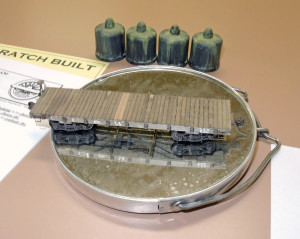

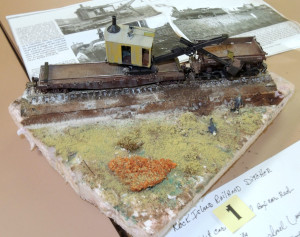
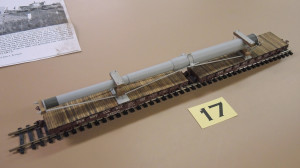
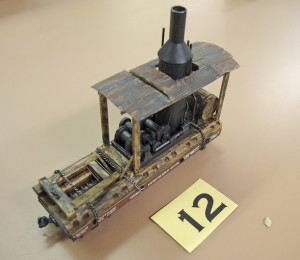
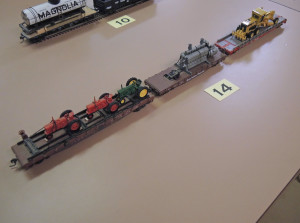
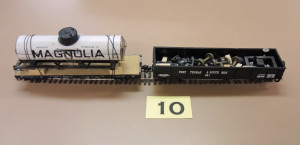
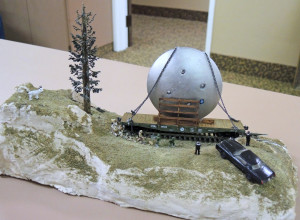
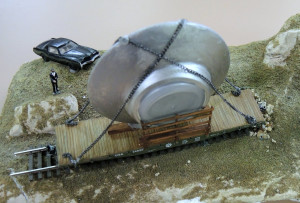
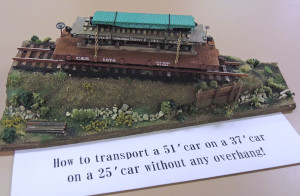
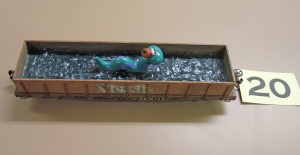
No Comments Yet